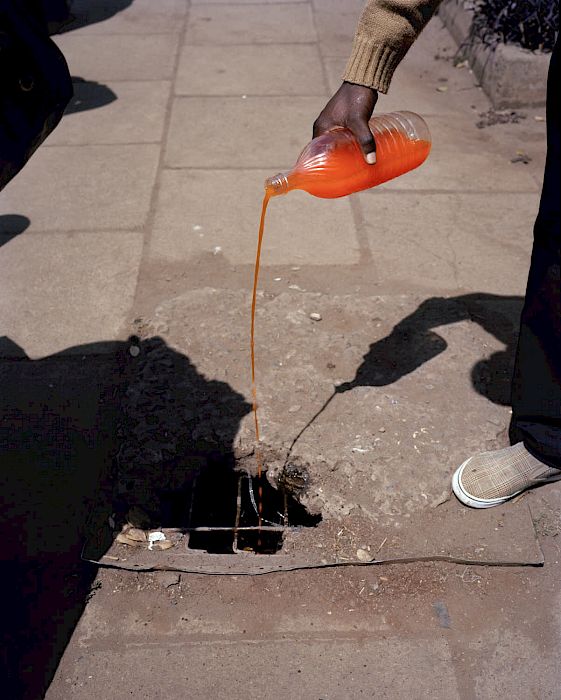Book Of The Week Hot Mirror Photographs by Viviane Sassen Reviewed by Owen Kobasz Viviane Sassen is one of today's most innovative photographers and this stunning book looks back at a decade of her work, including new collages and previously unpublished photographs.
Photographs by Viviane Sassen
Prestel, Munich, Germany, 2018.
160 pp., 95 color and 9 black-and-white illustrations, 9½x13x½".
Formally,
Hot Mirror is a mid-career retrospective. Pulling from
Umbra,
Flamboya,
Roxane II, and more, this new book contains a survey of Vivianne Sassen’s fine art photography to date, with an emphasis on surrealism.
Hot Mirror, however, doesn’t
feel like a retrospective, or at least not a traditional one.
Sassen’s previous publications were single series, each bound by a concrete thesis.
Hot Mirror breaks the mold by drawing a selection of her photographs from the past two decades and are revivifying them with a new context. Arranged asymmetrically and surrounded by a luxurious amount of negative space, the themes and colors are often juxtaposed, evoking a strange dreamlike feeling.
 |
| Luxaflex, from Of Mud and Lotus, 2017 |
The image,
Luxaflex, taken from
Of Mud and Lotus, shows two people twisted together. Green lines obscure their faces and bodies and the background — leaving just their arms, legs, and hair untouched. It’s as though everything has been censored save their limbs and hair, but her use of green makes it fun and playful. On the opposite page, sits
Mirror Man, a much older photo from the series
Flamboya. The mirror reflects a grey cinder block wall and a man stands in the gap. He is tilted forward so that his face is hidden behind the mirror. Sassen’s images allow only half to be seen, but the other half is just as important.
“I’m fascinated by what is hidden, but I think it’s fine for it to stay hidden. I don’t need to investigate everything, and that includes inside myself. So, there’s that discrepancy between revealing and concealing again,” she told Robbert Ammerlaan in an interview reproduced in Hot Mirror.
 |
| Menthe, from Flamboya, 2007 |
The subtle thesis of
Hot Mirror is surrealism, a movement that Sassen has long referenced as one of her primary influences. In these photographs, the parts can be easily identified — they show ordinary objects, people, and places — but put together, when the viewer tries to really understand exactly what is going on, it starts to break down. There is something off, out of place, like how a dream makes sense mid-dream but becomes absurd in hindsight. But then there is the third stage — when they become beautiful.
“Surrealism is the ability to experience or look at things in a way that's unbiased, free of judgment and convention — almost like looking through the eyes of a child.” — Vivianne Sassen
Spaced throughout the book on a thinner, translucent paper, is a tale titled
The Eye of the Eucalyptus Tree. Comprised of poetic text fragments, Sassen recalls memories from her childhood. Only a few lines long, each excerpt describes a moment, sensation, or family tradition — almost like snapshots from a time before the photographer carried her camera.
 |
| Fantôme, from Parasomnia, 2010 |
The last piece of
The Eye of the Eucalyptus reads:
“I would dream of baobabs coming to life at night and running around silently. I once found a squirrel on the bottom of a dry swimming pool, by a lodge not far from the Mara River. That squirrel was a bit strange, as it sang a beautiful song about loneliness in a foreign language. When it had finished, I wanted to say thank you, but it gave me a slightly superior look and disappeared down the drain of the swimming pool.”
A confusing dream seems a fitting conclusion to Hot Mirror. Like a Max Ernst painting, the photographs and text are not meant to be clear and intuitive, especially when taken as a group. Through them, however, Sassen is outlining something difficult to describe, something that leaves poets and painters alike tonged-tied.
The book ends with a strong essay by Eleanor Clayton, which gives the reader context for understanding the development of Sassen’s work and its relationship to surrealism. Towards the end of the essay she quotes from the
Manifesto of Surrealism by André Breton:
“In this dizzying race the images appear like the only guideposts of the mind. By slow degrees the mind becomes convinced of the supreme reality of these images… The mind becomes aware of the limitless expanses wherein its degrees are made manifest.”
Purchase Book
Owen Kobasz edits the blog & newsletter at
photo-eye. He holds a BA in the liberal arts from St. John's College and takes photos in his free time.















